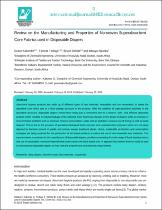 ResearchSpace
ResearchSpace
Review on the manufacturing and properties of nonwoven superabsorbent core fabrics used in disposable diapers
JavaScript is disabled for your browser. Some features of this site may not work without it.
- ResearchSpace
- →
- Research Publications/Outputs
- →
- Journal Articles
- →
- View Item
| dc.contributor.author |
Kakonke, G

|
|
| dc.contributor.author |
Tesfaye, T

|
|
| dc.contributor.author |
Sithole, Bishop B

|
|
| dc.contributor.author |
Ntunka, M

|
|
| dc.date.accessioned | 2019-09-25T07:10:11Z | |
| dc.date.available | 2019-09-25T07:10:11Z | |
| dc.date.issued | 2019-02 | |
| dc.identifier.citation | Kakonke, G., Tesfaye, T., Sithole, B., et al. 2019. Review on the manufacturing and properties of nonwoven superabsorbent core fabrics used in disposable diapers. International Journal of Chemical Sciences, vol 17(1), 21pp | en_US |
| dc.identifier.issn | 0972-768X | |
| dc.identifier.uri | DOI: 10.21767/0972-768X.1000300 | |
| dc.identifier.uri | https://www.tsijournals.com/articles/review-on-the-manufacturing-and-properties-of-nonwoven-superabsorbent-core-fabrics-used-in-disposable-diapers.pdf | |
| dc.identifier.uri | http://hdl.handle.net/10204/11128 | |
| dc.description | Copyright: 2019 Trade Science Inc | en_US |
| dc.description.abstract | Absorbent hygiene products are made up of different types of raw materials, renewables and non-renewables, to create the absorbent core which acts as a fluid storage structure in the product. With the addition of superabsorbent polymers in the absorbent structure, disposable diapers moved from being just a convenient item to a thinner, safer, and efficient absorbent product which resulted in reduced leakage of the collected fluid. Numerous changes in the design of diapers led to an increase in environmental problems such as excessive resource consumption, water and air pollution, excessive use of energy as well as waste disposal. This is due to the presence of specialized biological inert polymers and superabsorbent polymers which are not easily digested by bacteria present in public and private sewage treatment plants. Hence, sustainable production and consumption strategies are being explored for the production of bio-based products to reduce the use of non-renewable raw materials. This report reviews procedures for the manufacture of disposable diapers, problems emanating from the usage of fossil-based products and use of sustainably resourced materials that could replace the fossil-based ones. It appears that chicken feathers could be used to manufacture disposable diapers as they meet the property and characteristic requirements. | en_US |
| dc.language.iso | en | en_US |
| dc.publisher | Trade Science Inc | en_US |
| dc.relation.ispartofseries | Workflow;22636 | |
| dc.subject | Absorbent hygiene products | en_US |
| dc.subject | Absorbent pads | en_US |
| dc.subject | Baby diapers | en_US |
| dc.subject | Biological inert polymers | en_US |
| dc.subject | Fluid storage structure | en_US |
| dc.title | Review on the manufacturing and properties of nonwoven superabsorbent core fabrics used in disposable diapers | en_US |
| dc.type | Article | en_US |
| dc.identifier.apacitation | Kakonke, G., Tesfaye, T., Sithole, B. B., & Ntunka, M. (2019). Review on the manufacturing and properties of nonwoven superabsorbent core fabrics used in disposable diapers. http://hdl.handle.net/10204/11128 | en_ZA |
| dc.identifier.chicagocitation | Kakonke, G, T Tesfaye, Bishop B Sithole, and M Ntunka "Review on the manufacturing and properties of nonwoven superabsorbent core fabrics used in disposable diapers." (2019) http://hdl.handle.net/10204/11128 | en_ZA |
| dc.identifier.vancouvercitation | Kakonke G, Tesfaye T, Sithole BB, Ntunka M. Review on the manufacturing and properties of nonwoven superabsorbent core fabrics used in disposable diapers. 2019; http://hdl.handle.net/10204/11128. | en_ZA |
| dc.identifier.ris | TY - Article AU - Kakonke, G AU - Tesfaye, T AU - Sithole, Bishop B AU - Ntunka, M AB - Absorbent hygiene products are made up of different types of raw materials, renewables and non-renewables, to create the absorbent core which acts as a fluid storage structure in the product. With the addition of superabsorbent polymers in the absorbent structure, disposable diapers moved from being just a convenient item to a thinner, safer, and efficient absorbent product which resulted in reduced leakage of the collected fluid. Numerous changes in the design of diapers led to an increase in environmental problems such as excessive resource consumption, water and air pollution, excessive use of energy as well as waste disposal. This is due to the presence of specialized biological inert polymers and superabsorbent polymers which are not easily digested by bacteria present in public and private sewage treatment plants. Hence, sustainable production and consumption strategies are being explored for the production of bio-based products to reduce the use of non-renewable raw materials. This report reviews procedures for the manufacture of disposable diapers, problems emanating from the usage of fossil-based products and use of sustainably resourced materials that could replace the fossil-based ones. It appears that chicken feathers could be used to manufacture disposable diapers as they meet the property and characteristic requirements. DA - 2019-02 DB - ResearchSpace DP - CSIR KW - Absorbent hygiene products KW - Absorbent pads KW - Baby diapers KW - Biological inert polymers KW - Fluid storage structure LK - https://researchspace.csir.co.za PY - 2019 SM - 0972-768X T1 - Review on the manufacturing and properties of nonwoven superabsorbent core fabrics used in disposable diapers TI - Review on the manufacturing and properties of nonwoven superabsorbent core fabrics used in disposable diapers UR - http://hdl.handle.net/10204/11128 ER - | en_ZA |





